| By: Paul S. Cilwa | Viewed: 7/27/2024 Occurred: 2/14/1972 |
Page Views: 6323 | |
| Topics: #Wedding #MaryAnnSteinbergCilwa #Autobiography | |||
| Mary Ann Steinberg and I get married! | |||
I'm not saying I wish it hadn't happened. It happened perfectly. I adore my children and grandchildren and was friends with my ex-wife, up to and including being the one who became her caregiver when she came down with cancer. But it has to be said: my now ex-dead-father-in-law tricked me into marrying his daughter.
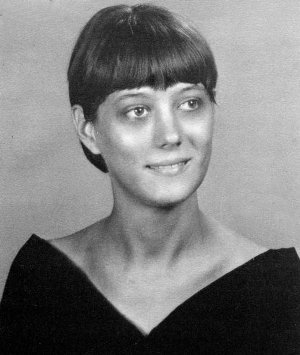
Mary and I had dated exclusively as seniors in high school. I liked her mom, but her father was, how can I put this nicely, a little nuts. Of course, looking back I realize it was a combination of the facts that he worshipped his only daughter, and was my grandfather's age, having been born the previous century. He had fought in the first world war, and still sometimes referred to it as "The Great War". So his ideas were somewhat antiquated. For example, every now and then he would wave a newspaper article in front of me about some woman found dead in her apartment and rant how it "all began when she moved out of her parent's house and lived on her own without a husband." I quickly found that these proclamations weren't meant as prologues to a conversation; they were the opening volleys to monologues that revealed his mores to be a little to the right of Attila the Hun as far as women's rights went. (He confided more than once that "this country began to go to the dogs" when women got the vote…an event he could remember!)
You don't want to know what he called any of Mary's friends whose skin was a different color from hers.
He was also an alcoholic, which his wife tried to control by refusing to give him the car keys. That didn't stop him; he simply paid cab drivers to purchase and deliver quarts of whatever it was he drank to the house. One evening he thought someone was trying to steal his car, and stood in his undershorts at the porch door and shot his own tires out so the imaginary thieves "couldn't get away".
Coming from a close-knit family myself, I knew that if I ever were to marry Mary, her father would be part of the deal. So when, shortly after our graduation from St. Joseph Academy, he called the police to bring us home just five minutes after her 11:00 pm curfew (we were just a block from her house), I called it quits. I don't know that either of us was happy about it, but I just couldn't deal with being 18 (and Mary was 20!) and being treated as if I were a 12-year-old hoodlum.
So I moved on and so did Mary. A couple of years passed by and now I was attending St. Johns River Junior College in Palatka, Florida. One day in November, 1971, Mary's father—the last person I expected to hear from!—called me and asked if he could pay me to put in a shelf in his closet.
As familiar as I was with closets at the time, I assure you I was the last person anyone would ask to do carpentry work. But I felt obligated to help out if an older person needed it and so drove over to his house.
I was finishing the job—with a lot of guidance—when Mary came home from an afternoon date with her new boyfriend, Mike. She was as surprised to see me as I was to be there. I was happy to see her, of course; my argument had been with her father, not her. And no one could deny she was a very beautiful young woman.
Of course I wanted to know what she was doing these days, and she told me about her work at the Florida School for the Deaf and Blind. I told her about junior college, and in a burst of friendliness, offered to escort her as my guest around the school one day if she liked. She accepted, and we decided to make the trip the following Thursday.
I picked her up as agreed (after settling on a return time of midnight, so as to avoid arrest) in the morning and we made the 45-minute drive past the Florida potato farms to Palatka and the campus. I took her to my classes in theatre and music and introduced her to my friends Mike Tucker, Johanna DeWitt and Kim Bartlett, and the head of the music department, George Champion. We ate at the Hungry Pelican (a fast food place where I also worked). It was a long but enjoyable day. It was dark by the time we returned to the coast, coming in on SR-206 instead of SR-207 so we could ride along the beach.
Actually, we parked on the beach, it being a mild, dark night, and listened to the surf crash while we talked about how we actually felt about each other and our being separated.
By the time I took Mary home, we were engaged to be married and had even set a date, February 12th.
There was a bit of an issue regarding Mary's wedding gown. Mary's mother gave her $85 for it, which of course wasn't enough to buy a wedding gown, even in 1972. However, her mother also "happened to know" a woman who would sew a wedding gown for…$85. Mary would have to supply the pattern and fabric; and she had no experience in doing such a thing. In fact, she didn't even know where patterns or fabric could be purchased. (Remember, this was in the days before Wal-Mart!)
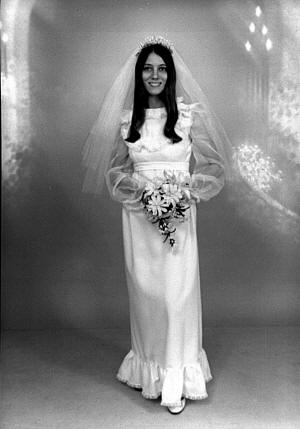
Luckily, my Aunt Edna had taught me those things. Plus, closeted or not, I doubt there's a gay man in the world who wouldn't jump at the chance to orchestrate a wedding! —It's the one thing all of us, top or bottom, twink or bear, urban or rural, seem to have in common. So I loved taking Mary to the fabric store and helping her go through the huge Simplicity Pattern catalogs, going over the various wedding gown designs and options. Mary selected a pattern, a graceful and simple classic empire with a frill around the bottom. The material was white, of course. And, a bonus: the pattern could also be used to create a matching "getaway" dress; Mary selected a jazzy red, orange and black material for that.
Both of us still being active in the Catholic Church, there was never any question regarding the location for our wedding: The Cathedral of St. Augustine. We chose to have a full Mass said; and not just any Mass. Ours would be a High Mass, which means there would be a full choir singing certain parts of the ceremony: namely, the Kyrie, the Gloria, the Credo, the Sanctus and the Agnus Dei. The choir was to be the entire chorus from my junior college; they were to sing Haydn's Mass in G Major, also known as the Missa Sancti Nicolai. Soprano Carol Alvers would have the featured solo for the Agnus Dei. Monsignor Burns, rector of the Cathedral itself, would officiate.
The location of the reception was another contribution by Mary's mother: The home of the local branch of the Catholic Daughters. Mary's mother also handled the guest list. All my relatives lived either in New Jersey or Florida's Gulf Coast, which I considered too far away to come for a wedding. So I didn't expect many of them to attend (and, in fact, none did). But I made sure my pals from SJRJC (St. Johns River Junior College) were invited and of course the rest of the choir would be there, as well.
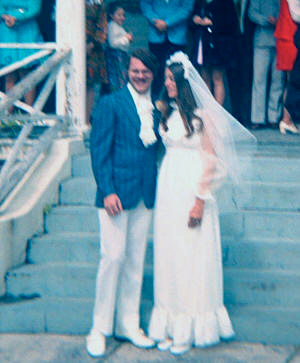
Then there was the matter of my attire. Tuxedo? I don't think so! I wore white slacks, with white shoes and socks, and an iridescent (it was the '70s) blue jacket. Since it was the '70s, I found I couldn't buy a simple white shirt—I went to five different stores in the attempt. All the white shirts then sold were made of a white-on-white embossed fabric which didn't match what I had in mind. So I made my own shirt (or, rather, shirt front) the night before the wedding. It consisted of a front and collar, which was all I needed because I wouldn't be removing my jacket. The final touch was a jabot, a cascade of lace ruffles popular in colonial days, which I also made myself due to the dearth of jabot stores at the time.
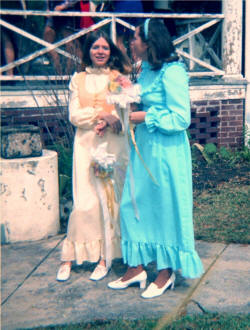
Neither Mary nor I could choose just one best friend to have as an attendant of honor. So, in addition to her matron of honor (Rosemary Hankins), she had an additional three bridesmaids, each in a dress made from the same pattern and type of material as Mary's but in a different pastel color the girl could choose for herself (as long as there were no duplicates). They had to get them from Mary's mother's seamstress friend, so she made out like a bandit. I hope Mary's mother got some kickback from the deal.
The bridesmaids had to pay for their own dresses, but were all assured they would be able to wear them again.
My best man was my closest high school friend, Chris Palmes. Junior college pals Mike Tucker and John Griffith gave me a matching phalanx. (It's important at a wedding that neither party appear to have more close friends than the other.) So as not to distract from the beauty of the bridesmaids (or the groom), though, the groomsmen were told to wear their regular Sunday-go-to-meetin' clothes. Mike was given the extra duty of carrying around my camera and taking the wedding pictures.
The day dawned. Sewing my own shirt had taken longer than I expected so I hadn't gotten enough sleep, but I took a long shower and that helped. I arrived at the church on time; so did the choir and they ran through a quick pre-service warm-up.
Then the guests began to arrive. As is traditional, Mary's friends and family sat on "her" side of the church, while mine sat on the other. Since we'd gone to high school together, we had numerous mutual friends who resented being compelled to "take sides". But a more serious imbalance soon became evident. It hadn't occurred to my Mom to invite her co-workers to the wedding; after all, most of them had never even met me. But Agnes, Mary's mother, had no such compunctions. She had invited all the ladies in the Catholic Daughters, and their husbands; and they all sat on the bride's side of the church. I easily had more people there than Mary; but almost all of mine were hidden in the choir loft. Agnes had won the first round.
The church organist, M. K. Murphy, began to play the Lohengrin and Mary began her walk down the aisle, beautiful and radiant. She received more than the usual amount of gasps of awe from the congregation—and if she had more photos taken of her than had been taken of me, I didn't mind.
The Mass started with the choir singing the Kyrie (the lyrics in English read "Lord, have mercy!" which struck me as being somewhat ominous for a wedding; but they are part of the Mass).
This was before the days of made-up vows; so Monsignor Burns simply recited them and we repeated after him. There were no mishaps with the rings and no mispronounced words. In fact, the only close call we had during the ceremony was when Monsignor invoked the names of the Apostle, Paul and the Virgin Mary. Mary and I began to giggle and couldn't stop, as it had been at least a month since virginity had been a feature of our relationship.
Monsignor Burns knew this was to be a High Mass but he hadn't asked which Mass the choir would be singing. And it hadn't occurred to me that Haydn's Mass in G Major might not be the best choice. It takes about 40 minutes to sing straight through, which, when added to the running time of a Mass (about 30 minutes) and the excess material in the wedding vows and appropriate homily (another 20) meant this service would run a lot longer than the usual wedding. So he began to get antsy. During the Agnus Dei, when Carol was singing her rather long (but beautiful) solo, Monsignor finally stood up and interrupted her with the Mass's concluding words. He said, "The Mass is ended; go in peace." The response is supposed to be made by the congregation. But when it was made, "Thanks be to God!" his voice was louder than anyone's.
We rode the block from the Cathedral to the Catholic Daughters' building a block away in a horse-drawn buggy—the first time for either of us, although the buggies were ubiquitous in tourist haven St. Augustine. Meanwhile, my car—our car—was parked behind our destination, where our friends were busily writing rude remarks on it with white shoe polish and attaching balloons and cans.
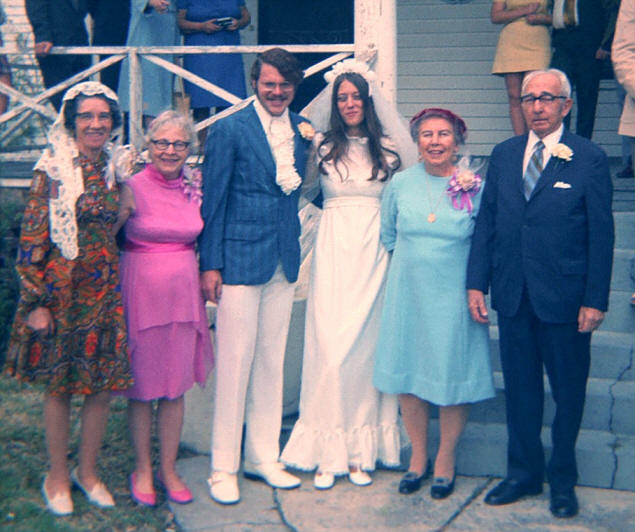
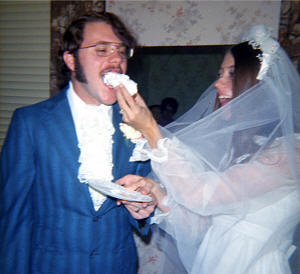
I suppose the reception could be called a success, because no one died during it. But it was a close call. Agnes was already in her 70s (Mary had been adopted) and so were all her Catholic Daughter friends. Her father was even older and so were his friends. My friends in the choir were simply outnumbered. Music came from a record player and the Daughters' Guy Lombardo record collection. There was food in the form of casseroles prepared by the ladies, especially a pungent chicken casserole that someone forced me to sample, and of course the wedding cake.
Fortunately, neither Mary nor I were expected to remain at the reception until it got rowdy. She changed into her "getaway" dress; and amid a rain of rice we ducked into the decorated car and set out on our three-day honeymoon.
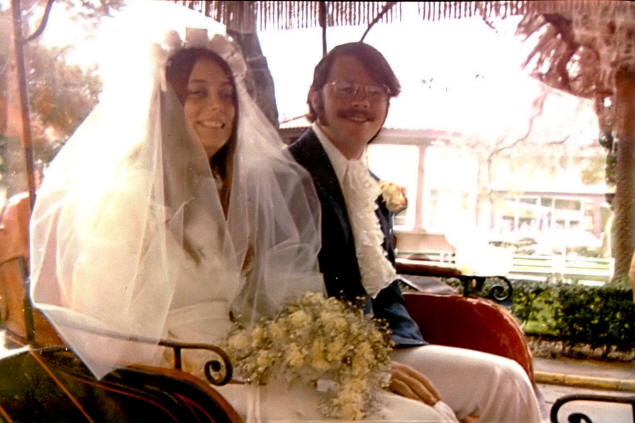
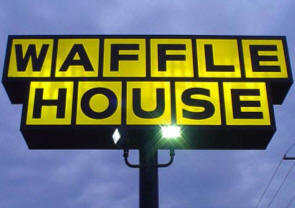
We had no fixed destination in mind; we had thought it might be fun to visit Tennessee, a state I had never visited. North of Jacksonville we stopped at a Waffle House for our first meal as a married couple. You can't begin to imagine my surprise when the waitress, having seen our car through the restaurant's conveniently large windows, informed us our meal would be free. "Why?" I asked.
"That's your car, right?" she asked.
"Yes," I agreed, following her finger.
"Well, we give free meals to newlyweds," and with a shrug that said, didn't you know that?, took our orders.
We ate at a different Waffle House for almost every meal of our honeymoon, and for months afterwards until the shoe polish finally wore off our car.
We both began to get sick that evening. At first I did suspect Waffle House. But I called home to let my Mom know where we were (as Mary called her parents) and we learned that pretty much everyone who'd eaten the chicken casserole had started throwing up.
I didn't have a lot of experience nursing people. Mary had been a nurses aide, but they are discouraged from actually diagnosing and treating illnesses. I got some Alka-Seltzer which helped me; Mary couldn't get it down but she did find that cans of carbonated Gatorade (which is no longer available, but it was good stuff) made her feel a little better.
We really didn't feel like participating in the traditional wedding night activities, but did rather than have to admit in future years that we didn't.
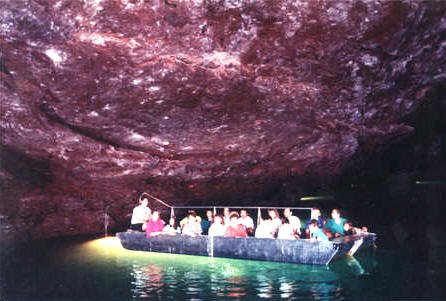
We made it to Chattanooga, Tennessee, where we rode the Incline Railway and visited the Lost Sea (a lake in a cave). Despite being sick and its being February and so cold and rainy we had a good time and I got lots of pictures.

When we finally returned to Florida and our brand new (for us) apartment in Palatka, I took the final picture of the roll of film, of Mary looking radiant and happy to be home. Then I tried to rewind the film, to remove it and get it processed. To my horror I discovered the film was damaged; thanks to a broken sprocket, all the photos—of the wedding and the honeymoon—had been taken on the same negative.
It took me years to gather together a set of pictures taken by our friends so I would have at least some record of our wedding day.
On the other hand, twenty years later when we separated there was no thick, expensive book of professional photos to either divide between us or throw out.





